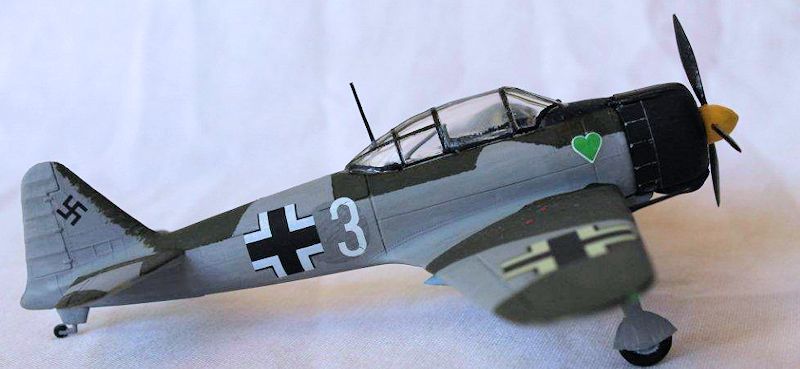
Airfix 1/72 A6M2 Zero
| KIT #: | |
| PRICE: | $6.00 |
| DECALS: | One option |
| REVIEWER: | George Oh |
| NOTES: | Old tool kit |

| HISTORY |
On
14 Sep, 1939, the Imperial Japanese Navy accepted the first of twenty 12-Shi
fighters from Mitsubishi. They were allocated the designation A6M2 and the name
Zero-sen.
The episode was celebrated by a parade for the new fighters which
culminated in a mass rapid take-off, a fly-past of the formation, then a mock
dog fight.
Observing the parade was an assistant to the German Military
Attaché, Leutnnant Hans Greuber, a Luftwaffe Officer.
Greuber was amazed at the agility of the new Japanese fighter and, after
flattering the Japanese Navy members about their new wonder plane, he politely
requested permission to have a close look at one.
The Japanese pilots fell over themselves to show-off
their new machines and to boast about its capabilities.
After a look at the new Zero-sen and reading its
technical manual, Greuber secretly noted its strengths and weaknesses.
Its agility, range and heavy armament had been bought at
the expense of robustness, self-sealing fuel tanks and armour-plating.
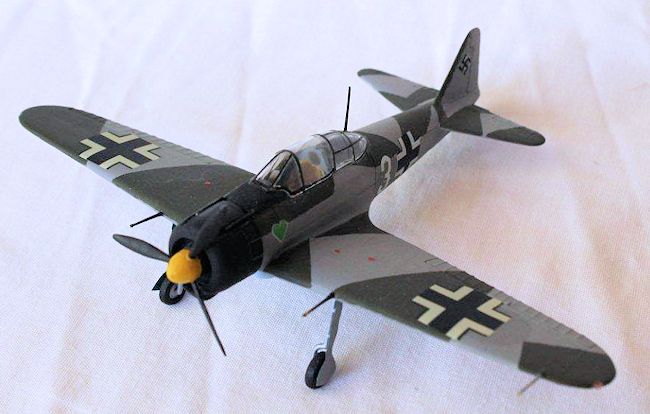 Eventually,
the IJN allowed Hans to fly one.
When he landed, he was outwardly delighted with the
Zero-sen because it was a beautifully light and well-balanced plane.
Though he noted that the controls became VERY heavy at
high speeds, quietly, he was very alarmed.
This thing could easily out-fly and out-last Germany’s
new Me.109.
In a secret report to Berlin, Greuber reported on the Zero-sen
and finished with a recommendation that the Luftwaffe buy one to examine in
detail.
Eventually,
the IJN allowed Hans to fly one.
When he landed, he was outwardly delighted with the
Zero-sen because it was a beautifully light and well-balanced plane.
Though he noted that the controls became VERY heavy at
high speeds, quietly, he was very alarmed.
This thing could easily out-fly and out-last Germany’s
new Me.109.
In a secret report to Berlin, Greuber reported on the Zero-sen
and finished with a recommendation that the Luftwaffe buy one to examine in
detail.
At
the end of his posting to Japan, Greuber was posted to Bad Wörishofen in
Barvaria and promoted to Haptmann.
Initially puzzled, he was delighted to find six
Zero-sens parked there.
Apparently General Ernst Udet had read his report and
had procured these six, and a host of spare parts, in a 1-for-1 exchange for
Messerschmits.
But these weren’t exactly like the Zeros-sen he had seen in Japan.
“Nein,” said General Udet.
“I had them modified a little to be more compatible with
the Luftwaffe.
The tail hook went to lighten the load – besides, the Kreigsmarine are nowhere
near completing the Graf
Zeppelin yet.
The instruments, radio equipment and gunsights have
naturally been replaced by German equipment, as have the weapons (you have two
7.92mm MG-17s in the nose and a 20mm MG-FF cannon in each wing).
The middle cockpit canopy section has been substituted
for a new one, similar to the clear bubble of the Spitfire.
The Japanese one had struts all over the place.
I had the engineers put-in some steel roll-over
protection for your thick head should you want to flip one of these onto its
back.
And I having new wheel rims manufactured so that it can be fitted with
German tires later.
The Japanese didn’t send too many tires.
Oh, and I had those big red circles painted-out.
Gruber’s new job was to assess suitability of the Zero-sen for Luftwaffe
operations.
He set about canvassing the Luftwaffe ranks for pilots to fly
them, but returns were disappointing.
Most pilots looked at the specs of the Zero-sen, branded
it a deathtrap, and refused to fly it.
The aircraft designers, Willie Messerschmitt & Ernest
Hienkel, were even less complimentary about the Zero-sen.
It was difficult, but eventually Hans found four
experienced pilots who were willing (and in one case, blackmailed) to fly the
Zero-sen (I have photos of you as Brunhilda in the Staff Cadet opera).
 Greuber’s
Schwarm of Zero-sens became a common sight in the skies over Bad Wörishofen as
the pilots quickly became acquainted with their new mounts.
Like Hans, they appreciated the Zero-sen’s nimbleness in
a dog-fight, while ignoring its deficiencies (for now).
And they shortened its name to Zero.
Greuber’s
Schwarm of Zero-sens became a common sight in the skies over Bad Wörishofen as
the pilots quickly became acquainted with their new mounts.
Like Hans, they appreciated the Zero-sen’s nimbleness in
a dog-fight, while ignoring its deficiencies (for now).
And they shortened its name to Zero.
Then came the day in September when orders were received for the Schwarm to be
disbanded.
The pilots were needed in operational Staffells engaging the RAF
over England.
Hans protested strongly to OKL, and raged around the airfield.
However, he had an idea that would prove the Zero – if
only he could fore-stall the closure order till after the Reichmarshall’s
airshow in Berlin.
Getting an invitation for the schwarm to perform at the
airshow was easy as one of his pilots was dating the secretary of the Orbost who
was arranging it.
She simply typed their Unit at the bottom of the list
(AFTER the Orbost had signed it).
On
the day of the airshow, Greuber and his pilots were confident but tense.
Their four Zeros were to be quickly ‘shot-down’ in a
mock dog-fight against a larger number of Me.109’s.
Afterwards, the Messerschmitts were to land for a
demonstration of a rapid refuelling and rearming.
Right on schedule, Greuber followed by his Schwarm flew along the Berlin
aerodrome, and, equally on cue, the Staffel of Messerschmitts dived down to
bounce them – and got the shock of their lives.
The excellent visibility from the Zero’s new canopy
allowed the Schwam pilots to see the Messerschmitts early, and they pulled-up
sharply into them, causing them to scatter.
From then on, the Zeros seemed to be able to roar-in on
the side of every Messerschmitt, thanks to a new weaving tactic that the schwarm
had devised (and practiced in secret).
The dog-fight seemed to go on for an hour instead of the actual four minutes.
And instead of clearing the sky when the Messeschmitts
landed, the Zeros continued to stage mock attacks on them as the Blackmen
refuelled and rearmed the Staffel.
And they kept it up for the twenty minutes of the fast
turn around.
All the time, the ground controller screamed at them to leave
because they were disrupting the schedule – to which Greuber calmly replied that
they would fly escort for all subsequent display aircraft and that they would
land after the show.
The airshow continued for another hour and forty minutes
during which the Schwarm did exactly that.
After it had ended, Hans brought his Schwarm in to land,
and they were met by a detachment of Military Police who drove them to the
control tower with
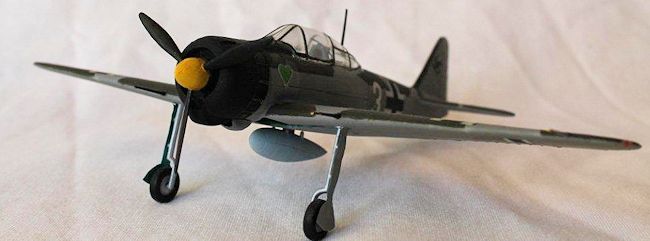 surprising
courtesy.
Greuber grinned to his pilots and said “Well Gentlemen, I might
be a Private by tonight”.
surprising
courtesy.
Greuber grinned to his pilots and said “Well Gentlemen, I might
be a Private by tonight”.
They were marched-in to the Kommandant’s office, but sitting behind the desk was
the Reichmarshall himself.
“Pretty good flying,” he said.
“Now, exactly how long were you boys in the air?”
“Two hours and twenty minutes, Sir.”
And Hans, his pilots, and the Reichmarshall had a long,
frank discussion about the technical and tactical merits of the Zero.
He even mentioned their weaknesses.
“Herr Reichmarshall, the Zero does not need armour
plating because a Spitfire will not be able to hold us in his sights.
Today’s gun-camera footage will prove it”.
That night, Greuber and his pilots watched the
gun-camera footage that told them that they had shot-down eleven of the
Messerschmitts – several of them had been shot-down twice, and one three times.
As they ate the Reichmarshall’s very good food (and
drank his very fine wine and smoked his very fine cigars), they gleefully
listened to the Reichmarshall deflect Herr Messerschmitt’s angry words about the
Zeros.
A
week later, the Schwarm, was attached as an independent Unit to Adolf Galland’s
“Green Hearts”, with orders to report directly to the Reichmarshall.
Before departing for France, a Luftwaffe camouflage
pattern was quickly painted over the monotone grey of the Japanese Navy, and
extra-large Balkenkruezs were painted on the upper wings so that other Luftwaffe
aircrews wouldn’t mistake the strange new aircraft for RAF planes.
Their departure was delayed by two days because, at
Hans’ insistence, the external fittings were exchanged so that the Zeros could
carry a standard Messerschmitt external fuel tank.
On
that first day, they took-off from France to look for trouble over England.
And they found it.
The Schwarm proved that the Zeros could indeed turn
inside even the much-vaunted Spitfire.
After a whole morning over England, the Schwarm returned
to France to rearm, and claimed twelve Spitfires destroyed.
That afternoon when they returned from England, they
claimed another fifteen Spitfires, all without even receiving a single
bullet-strike.
After his flight in a Zero, in-which he had a dog-fight with a schwarm of
Me.109’s, Galland said “Bugger the Spitfires.
I’ll have a squadron of these!”.
Reality----
 On May 19,
1937, the Japanese Imperial Navy submitted specifications for a new navy fighter
to replace the Mitsubishi A5M, Navy Type 96 Carrier Fighter.
The Mitsubishi design team was led by Jiro Horikoshi,
and they submitted the Mitsubishi A6M1 prototype.
It was an all metal, low-wing monoplane with retractable
undercarriage, and powered by a 780hp/580kW
Mitsubishi Zuisei 13
engine.
Apart from maximum speed, the new aircraft met (or exceeded) all of the
IJN requirements.
Still, the aircraft was upgraded with a 925hp/690kW
Nakajima NK1C Sakae 12
engine and a three-blade variable pitch propeller to
become the A6M2.
On May 19,
1937, the Japanese Imperial Navy submitted specifications for a new navy fighter
to replace the Mitsubishi A5M, Navy Type 96 Carrier Fighter.
The Mitsubishi design team was led by Jiro Horikoshi,
and they submitted the Mitsubishi A6M1 prototype.
It was an all metal, low-wing monoplane with retractable
undercarriage, and powered by a 780hp/580kW
Mitsubishi Zuisei 13
engine.
Apart from maximum speed, the new aircraft met (or exceeded) all of the
IJN requirements.
Still, the aircraft was upgraded with a 925hp/690kW
Nakajima NK1C Sakae 12
engine and a three-blade variable pitch propeller to
become the A6M2.
The IJN assigned 15 A6M2s to combat trials in China, where they
destroyed 99 Chinese aircraft with a loss of only 2 of their own.
Modifications introduced during production included a
reinforced rear spar and manually folding wingtips.
With its maximum speed of 331mph/532 km/h and the
ability to climb to 6,000 m in 7.5 minutes, it possessed an ascendancy over any
other fighter type in the Pacific – or Europe.
Despite receiving reports from China, the A6M2 came as a
nasty surprise to the Allies when it was encountered in combat.
To the Japanese, the aircraft was the Zero-sen.
To the Allies, it became the Zeke, and then the Zero.
Knowing that the RAAF Spitfire Mk.VIIIs over Darwin, Australia, had a hard time
dominating the Zero, I once had a disturbing notion of German Zeros easily
besting Spitfires during the Battle of Britain.
So I set-out to find an inexpensive early-model Zero to
make it a scale reality on my shelf.
Later Zeros were easy to find, but an early one wasn’t,
till I saw this one on-line, in the Rare-Plane Detective in Las Vages, Nevada,
USA (G’Day Jeff).
It was only one of the items of my first buy from Jeff,
who is a great bloke.
I got because it was that it was exactly what I wanted,
and because it didn’t cost a lot.
| THE KIT |
| CONSTRUCTION |
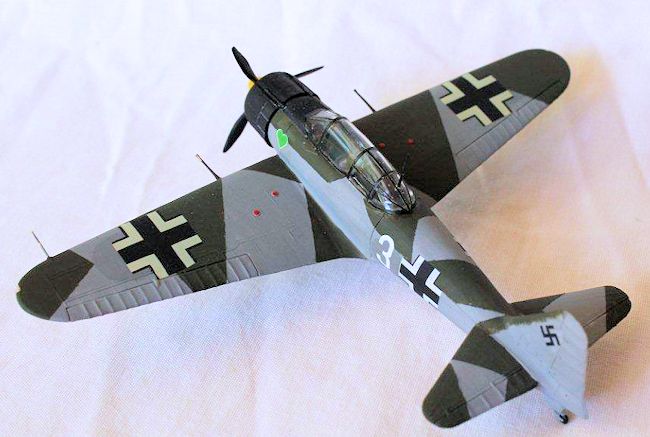
During dry-fitting, I saw that the wheel wells weren’t deep enough for the
wheels, that there was a huge gap between the wing trailing edge & the belly of
the fuselage, that the two chin-mounted intakes would need major work to make
them look right, and that the cowling wouldn’t fit the fuselage without some
heavy-duty cutting.
Within minutes of opening the box, I had the tail-planes on, and I was scribing
at the upper wings and fuselage to deepen the wheel wells.
I’ll need a roof in there, ‘else you’ll see right
through to the pilot’s boots.
On
the inside, a few sidewall panels and bumps followed; as did an instrument panel
complete with the butts of the machineguns that project into the cockpit.
With the cockpit tub established and painted the
greenish colour of the Japanese, I added the way-fat arrestor hook, and closed
the fuselage.
I reckon that the Luftwaffe woulda removed the hook (to reduce
weight, and because the Kreigsmarine had no carrier) and plated-over the well.
In reality, I left the hook in-place so that my thin
sheet-plastic belly-plate would have something to lean-on.
 In an
attempt to eliminate the fuselage/wingroot gaps, I attached the upper wing
halves to the fuselage.
The dihedrals of the wings was kept right by holding
them in-place with the lower wing piece.
Only one side worked.
The other side needed a shim of plastic card (and
filling & sanding etc) to position it just right.
About now, I significantly reduced the raised details by
sanding-down the whole model. Underneath,
I scribed the outline of the flaps, just to break-up the plainness of the
underside.
In an
attempt to eliminate the fuselage/wingroot gaps, I attached the upper wing
halves to the fuselage.
The dihedrals of the wings was kept right by holding
them in-place with the lower wing piece.
Only one side worked.
The other side needed a shim of plastic card (and
filling & sanding etc) to position it just right.
About now, I significantly reduced the raised details by
sanding-down the whole model. Underneath,
I scribed the outline of the flaps, just to break-up the plainness of the
underside.
The cowling was moulded with gills moulded flared and incredibly thick (a common Airfix trait that I hate). As per normal, I ground/cut/sanded them flush with the cowling, then scribed-in the lines of the individual cowling flaps. The cowling still needed some persuasion to attach neatly to the front of the fuselage, and there was a chin-mounted intake that opened directly into the underside of the cowling. For the heck of it, I placed a thin plate/septum between the two. It was made from paper, solidified with liquid superglue.
| COLORS & MARKINGS |
My
attack plan was to paint this model like the Zeros that hit Pearl Harbour, then
to apply splinter and mottled cam over the top.
So the whole model received an overall coat of Tamiya
IJN light grey (not white). I
also wanted it to be obvious that the Japanese hinomaru had been painted-over
with a paint that was close to, but not quite the colour of, the Japanese
livery.
So from Tamiya tape, I cut stencils of
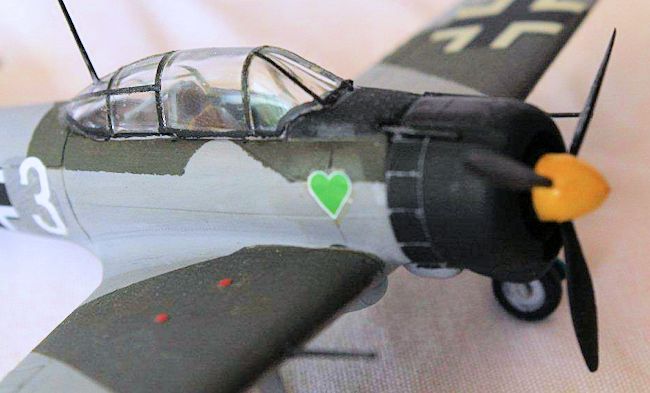 the hinomaru,
positioned them, then painted over the base coat with the same grey, darkened
with a touch of black, to impart a faint but noticeable difference.
Some dark green splinter cam followed on the wing-tops
and the spine.
The mottling on the fuselage sides was dumped because there
wasn’t much room and I wanted to get this done while I was enthusiastic about
the project (besides, I’m afraid to have a go at doing a mottle – let alone a
whole fuselage of it).
Coats of Future followed.
The cowling was painted black as per IJN aircraft, as
was the nose deck, because it’ll look like an anti-dazzle pattern.
Later, I’d extend it to the back of the canopy area.
the hinomaru,
positioned them, then painted over the base coat with the same grey, darkened
with a touch of black, to impart a faint but noticeable difference.
Some dark green splinter cam followed on the wing-tops
and the spine.
The mottling on the fuselage sides was dumped because there
wasn’t much room and I wanted to get this done while I was enthusiastic about
the project (besides, I’m afraid to have a go at doing a mottle – let alone a
whole fuselage of it).
Coats of Future followed.
The cowling was painted black as per IJN aircraft, as
was the nose deck, because it’ll look like an anti-dazzle pattern.
Later, I’d extend it to the back of the canopy area.
I had a set of 48-scale FW.190a decals, so I used these to give this Zero larger-than-normal balkencruzes on the wing tops (I saw a photo of a Heinkel 111 over Poland, with oversized crosses). The rest of the decals were stolen from a Messerschmitt that I’d painted Red Baron style (but that’s another story), so the rest of the markings were standard crosses. The tail swastikas came from a sheet of spares, as did the number 3. My good friend Don Williams of Moonie Ponds Models gave me the two 72-scale Green Hearts emblems I sought for my Zero to keep in line with my story.
| FINAL CONSTRUCTION |
I
added all of the last bits, like the undercarriage and roll-over protection for
the pilot.
The undercarriage doors were way too thick, so I replaced them
with ones cut from thin foil.
At the last second, I decided to convert the much-ribbed
Japanese canopy (well, the centre section, at any rate) into an FW.190-style
bubble.
I did this to reduce the amount of masking I’d have to do (OK – so I’m
lazy), and did it by merely polishing the canopy till it was smooth.
This process is made easier by first filling it with
plaster.
Add the antenna mast and she was done.
Nope – add the propeller.
I painted the spinner yellow because all BoB
Messerschmitts seemed to have yellow spinners – and it adds a splash
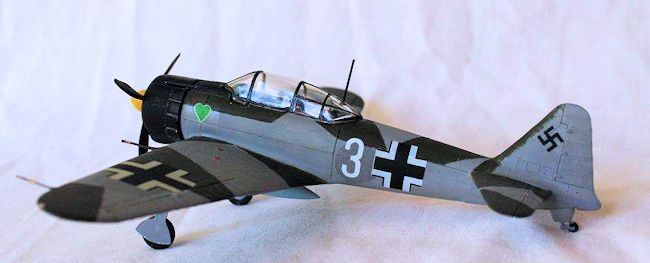 of colour.
For another splash of colour, I dumped the kit
torpedo-shaped IJN droptank, and replaced it with a lightblue Luftwaffe one.
OK – I know that such droptanks weren’t introduced to
the Luftwaffe till later in the war, but I wanted the colour.
From another model (a Hasegawa Ki.84 FRANK) I saw that
the fuel caps were painted red, so this model got red caps too.
The usual wingtip lights were added for their colour.
They were just nicks cut with a file, into-which I put a
dot of colour, then a little Krystal Kleer.
of colour.
For another splash of colour, I dumped the kit
torpedo-shaped IJN droptank, and replaced it with a lightblue Luftwaffe one.
OK – I know that such droptanks weren’t introduced to
the Luftwaffe till later in the war, but I wanted the colour.
From another model (a Hasegawa Ki.84 FRANK) I saw that
the fuel caps were painted red, so this model got red caps too.
The usual wingtip lights were added for their colour.
They were just nicks cut with a file, into-which I put a
dot of colour, then a little Krystal Kleer.
Another one completed.
Or so I thought – then I found a set of beautiful,
turned-brass barrels for a Zero produced by Masters.
At $4, they’d enhance the model and wouldn’t break the
bank.
I fitted the nose machinegun barrels, and found that the alignment
between the gun positions and the gun troughs was poor.
The cannon barrels I fitted sticking-out from the wings
to replicate the Me.109E – but more-so, ‘cos I like guns.
| CONCLUSIONS |
While my build was in-progress, I wrote the (possibly excessively-long)
background story.
I find that it helped me plan the complete build.
Unfortunately, after the photography session, I realised
that I’d not provided the Zero with it’s inner doors for the undercarriage, or
an antenna wire.
This is not the only Luftwaffe Zero in existence, because, after seeing my model developing, Don started, and completed, a 48-scale Luftwaffe Zero of his own - before I’d finished mine. You can do that when you own a hobby shop and have nothing to do but build models and serve customers. He also wrote a shorter story (in the form of an RAF Intelligence Report). But this one Luftwaffe Zero is mine, and I enjoyed building it. I have seen photos of a brilliant Airfix Zero by another modeller (G’Day Allan B) who had gone to town on it, but I’m not that good (neither is my Zero). AND, I’ve seen a photo and a model of a MIKE – an Me.109E in Japanese markings.
December 2014
If you would like your product reviewed fairly and fairly quickly, please contact the editor or see other details in the Note to Contributors.